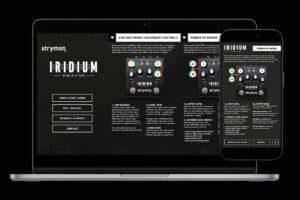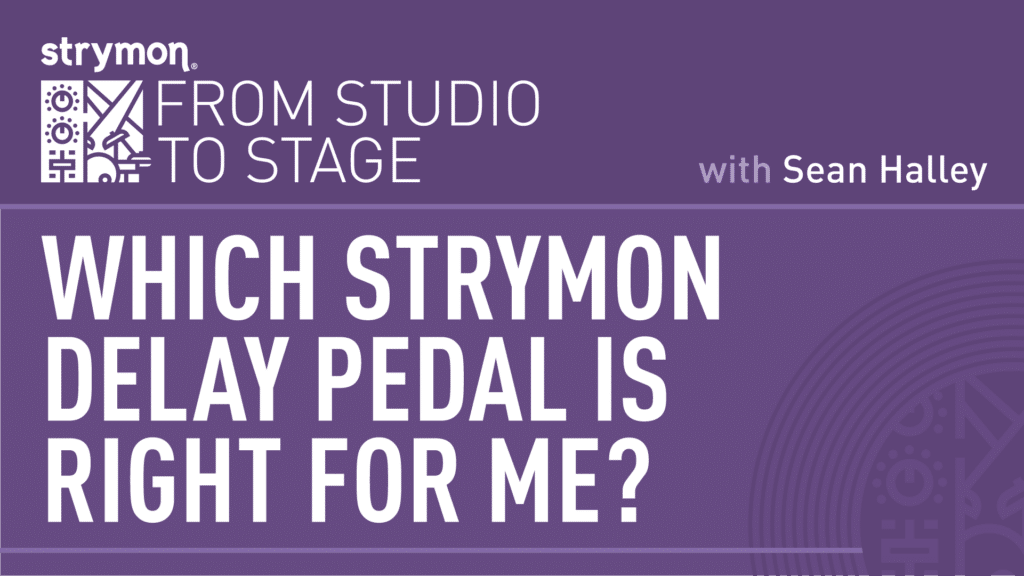
Secondary Controls Quick Start Guide Available Now!
If you happen to be one of those Strymon owners who know that their favorite units might have some extra capabilities but can’t remember exactly
Free US Shipping On Orders Over $49
Easy 30-Day Returns
Financing Available Through ![]()

With all the different types of delay and echo pedals that Strymon makes, we occasionally hear that it can be daunting to figure out which one (or ones) to settle on for your pedalboard.
Strymon delays come in all manner of different shapes and colors, with some dedicated towards a certain type of delay sound, and some having a wide variety of different personalities. In this blog I’ll provide some tips on how to choose between the various Strymon delay pedals in hopes that it makes the task much easier!
If you’re just starting out and are new to the world of delay and echo, a bit of personal experimentation is always a good thing to prioritize. I can make suggestions and be descriptive about the different types of sounds available, but knowing what you like is an important part of the equation. It takes time to get that experience, so we might as well enjoy the journey – and hey, we get to play guitar while learning new stuff, so it’s a win-win situation!
When choosing the right delay pedal, you have a variety of variables to sift through, so it’s good to know the difference between what you really need and what features would be nice to have.
Some things to consider:
• How many different flavors of delay do I need in the same enclosure?
• Am I looking for the characteristics of analog delays, or do I want something different?
• If I’m looking for analog, do I want bucket brigade-style behavior, or tape or drum-based sounds?
• Do I need to be able to pan the repeats?
• Do I need to sync to MIDI?
• Do I need to be able to tap tempo without any audio artifacts as the delay time changes?
• Does the size of the pedal enclosure matter?
• Do I need USB connectivity?
As you can see, there’s a lot to think about! This is why it’s important to find out what you like, so that you can balance what you want (say, tape-based behavior) with what you need (a rather small pedal enclosure due to lack of space on your board).
Let’s start with a general description of the sonics. Each Strymon delay algorithm was exhaustively researched, and then tuned to recreate the precise behavior of the type of machine or circuit being studied. We can start by looking at two of the distinctive and hyper-accurate algorithms that power a number of different Strymon pedals:
dBucket — this algorithm precisely recreates the full behavior of bucket brigade chips, which have a distinctive sonic character and were originally used in analog pedals for chorus and flange as well as delay and echo. These chips power the delays you’ve heard at the end of ‘OK Computer’-era Radiohead songs, where tweaking the Time pot after playing creates looped chaos, raising and lowering the pitch as the looped audio speeds up and slows down. That kind of behavior is indispensable for certain types of music, and it can get properly addicting to play around with the repeats. Depending on how much voltage they’re given to run on, bucket brigade chips can sound very clean or slightly grungy, either of which can add distinctive character to your delay sound.
Strymon pedals that use or include the dBucket algorithm include TimeLine, Ola, Orbit and the brilliant all-new Brig.
dTape — this algorithm precisely recreates the character and vibe of tape and tape machines, so you not only get the warmth and smoothness that you’d expect from a well-maintained professional tape machine, but you also get control over the amount of crinkle that a piece of tape has, how old it is and the condition of the machine itself. These are the kinds of delays and echoes that spawned the entire effects industry in the first place, since as we say in Deco parlance, “tape is the first effect”. Tape machines capture audio, repeat it and feed it back in a very distinctive way, and some of the most important songs in history wouldn’t have been the same without their use as an effect unit.
Strymon pedals that use or include the dTape algorithm include TimeLine, El Capistan, Volante, and Deco.
You often hear of guitarists that feel that digital delays are boring and lack character, but that’s simply not the case when you study the top early rack units used in studios in the eighties. Different eras of digital delay had tons of character, in part due to the particular technique used for converting the analog signal to digital and then back again, and in part due to the way that modulation was incorporated and achieved. All of this stuff is taken into account in our algorithms, and the delays really do behave precisely like the original devices that were studied in the research phase – and these sounds are absolutely not boring!
In addition to the three primary algorithms mentioned above, there are plenty of other flavors of delay available in the Strymon universe: filtered, pitched, Lo-fi, swelled, ducked or pattern-based machines are available as well, but those algorithms are only available inside TimeLine. If you need the ultimate library of delay algorithms in a single enclosure, this is the pedal for you – because it is THE delay workstation. It’s on more pro boards than any other delay pedal by a large margin for a reason.
Now that we know more about the different sounds available, we can go back to our list of variables and add some detail to give us a better picture of how the pedals compare to each other:

Hopefully, the chart above will make it easier to make a decision once you know more about what sounds you prefer and what the other important variables to consider are. For instance, if you knew that you wanted rack-style digital delays, you’d choose between the super-flexibility of TimeLine and the dedicated focus of DIG. TimeLine is a larger/more complex pedal and can technically do a bunch more than DIG can, but DIG has a simple interface, is smaller, has USB-C and can do two digital delay algorithms at once with a separate mix control for each. Which one to choose is up to you!
Perhaps you’re a musician who plays a lot of ambient music – TimeLine, El Capistan and Volante could potentially be the units to consider, even though DIG does a killer job at long ambient soundscapes too.
Need rock-solid MIDI clock sync for some House of Worship/U2 kinds of delayed guitar parts that need to be perfectly in time? DIG or TimeLine might be the best picks for you. Remember, the journey is the fun part!
I hope this helps bring some clarity to all the options you have when considering Strymon delays. I would suggest checking out our website and YouTube channel for more detailed product information and audio examples of all the pedals listed here, so that you can start to get an idea of which kinds of sounds you prefer.
And jeez, now you’ll probably need a reverb pedal! 😜
More in a bit!
Subscribe to our newsletter to be the first to hear about new Strymon products, artist features, and behind the scenes content!

If you happen to be one of those Strymon owners who know that their favorite units might have some extra capabilities but can’t remember exactly

From our favorite artists’ new releases to amazing concerts, and existing artists we’re just finding out about, 2024 was a year filled with great music.

We’re excited to announce the latest update to Nixie 2, now supporting six additional pedals: Volante, El Capistan, Flint, DIG, Deco, and blueSky. Along with these new additions, Nixie 2 already
2 Responses
I saw Kenny Vaughn using the volante and got me one- it has truly been a life changing experience for me . I also run a Flint and a Cloudburst in my board- that sound rings in my head 24/7 .
No mention of Brigadier?